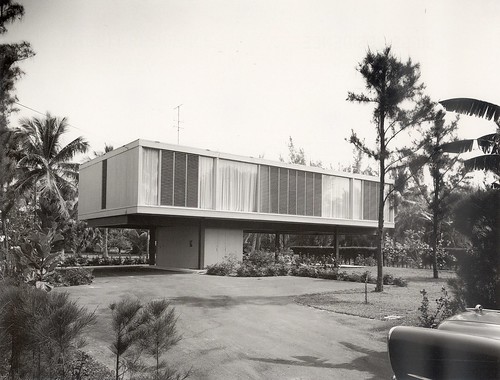Sarasota is either a big town or a small city, depending I guess on how you define the terms, but it certainly isn’t a metropolis. Which, of course, is one of the things we like about it. Something else we like about it is its impressive architectural heritage, one made especially impressive by its relatively small size. It even has an eponymous style of architecture, the “Sarasota School,” or “Sarasota Modern,” pioneered by well-known modernists including Paul Rudolph, Ralph Twitchell, Victor Lundy, Philip Hiss, and Gene Leedy. Examples can be found at Lido Shores, in Burns Square, and scattered around the rest of downtown Sarasota.
Add to its modern legacy an older, more vernacular (and ever charming) one of so-called Florida Cracker bungalows, like the ones we rent here at Laurel Park Management, and Sarasota punches above its weight class. For those of us who truly love quality Sarasotan architecture, the kind that people will be proud to live or work in 100 years from now, that passersby will stop to admire, that students will study, it hurts to see how many disposable buildings have also sprung up. The strip-malls and such, buildings raised to make a buck and little else. So we were thrilled to discover another small city with an elevated architectural pedigree. Looks like we need to step up our game…
Columbus, Ind., looks like any other small town, with its small shops and restaurants. But what sets this town apart is its architecture.
The Modernist buildings — mostly geometric and made of glass and steel — are not immediately visible, interspersed as they are with old, 19th-century, gingerbread-like structures; but more than 60 public buildings in Columbus have been built by a veritable who’s who of modern masters — I.M. Pei, Eero and Eliel Saarinen, Cesar Pelli, Richard Meier, Harry Weese, Robert Venturi and James Polshek, to name a few.
In 1991, the American Institute of Architects rated Columbus sixth on its list of the top 10 American cities for architectural quality and innovation, right up there with Chicago, New York and San Francisco. That’s pretty amazing for a town of just 44,000 residents. Six of the city’s modern buildings have also been designated as national historic landmarks, and enough people travel from nearby towns and states — and even other countries — to see them that the local visitors center gives walking tours.
One such tour takes you past a large, arch-like sculpture by English artist Henry Moore. It sits across from a library designed by architect I.M. Pei and built in 1969. The building’s facade is made of brick with nearly invisible mortar — Pei mixed red brick dust into the white mortar to make it blend in.
The first modern building in Columbus is opposite the library. Finnish architect Eliel Saarinen built the First Christian Church in 1942. Grim and factory-like, the church has a tall, rectangular tower and small, rectangular windows. It helped launch a local design revolution that World War II promptly put on hold. Then, in the 1960s, thanks to some design-conscious decisions by the biggest business in town, the architectural revolution soared, with schools, fire stations, an all-glass bank, a courthouse, city hall, a world-class golf course and a jail — a really attractive jail.
As tour guide Bob Bishop puts it, “This is Columbus. We don’t build anything that isn’t attractive.” continue reading at npr.org
Wouldn’t this be a great mantra for Sarasota to adopt, and adhere to? We certainly have enough historic precedent to know good architecture when we see it.


